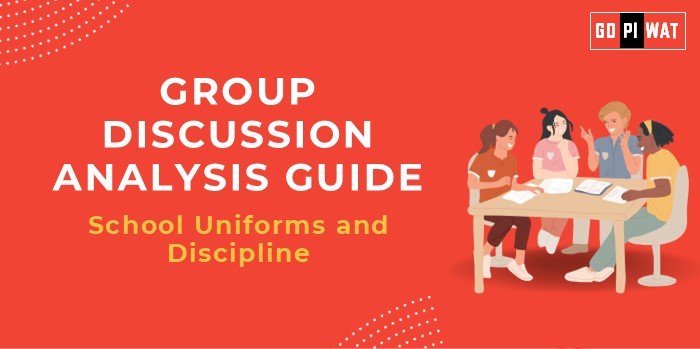📋 GD Analysis: School Uniforms and Discipline
🌐 Introduction to School Uniforms and Discipline
📖 The implementation of school uniforms is a widely debated practice in educational systems worldwide, often justified by the belief that uniforms foster discipline and create a conducive learning environment. This topic is significant for B-school students as it intersects with themes of organizational behavior, policy implementation, and the broader impact of standardization on culture.
Originating in 16th-century England, school uniforms were initially introduced to instill a sense of equality and discipline among students. In contemporary education systems, uniforms are often viewed as tools to reduce distractions, minimize socioeconomic disparities, and promote a focused academic atmosphere. However, debates persist around whether they genuinely promote discipline or merely suppress individuality.
📊 Quick Facts and Key Statistics
- 🌍 Global Adoption: Approximately 20% of public schools in the United States have adopted uniform policies, reflecting a growing trend toward standardizing student attire to enhance focus and reduce behavioral issues.
- 📈 Discipline Improvement: A 2016 study found that schools with uniform policies reported improved discipline, including enhanced attentiveness and timely class starts.
- 💰 Reduced Clothing Costs: Uniforms can reduce annual clothing expenses by 30-50%, alleviating financial pressure on families while promoting dress equity among students.
- 🛡️ Safety and Identification: Uniforms make students easily identifiable, which helps enhance campus safety and security.
- 📚 Mixed Academic Impact: Research suggests that while uniforms may enhance discipline, their direct effect on academic performance is less conclusive.
🤝 Stakeholders and Their Roles
- 🏫 Educational Institutions: Develop and enforce uniform policies aimed at creating a disciplined learning environment and upholding institutional standards.
- 👨👩👧 Parents and Guardians: Provide input on uniform policies, balancing concerns about cost, practicality, and student comfort.
- 🎓 Students: Directly impacted by uniform policies, students’ feedback is essential in evaluating the effects on comfort, self-expression, and discipline.
- 🏛️ Policymakers: Establish guidelines and regulations regarding school uniforms, considering cultural, economic, and social factors.
🎯 Achievements and Challenges
🌟 Achievements:
- 📈 Enhanced Discipline: Uniforms contribute to a disciplined environment by reducing distractions and encouraging students to focus on academics.
- 🤝 Equality Promotion: By standardizing dress, uniforms help minimize visible socioeconomic disparities, reducing peer pressure associated with attire.
- 🛡️ Safety Improvement: Uniforms make it easier to identify students and potential intruders on campus, enhancing school security.
⚠️ Challenges:
- 🎭 Suppression of Individuality: Critics argue that uniforms limit students’ ability to express their identities through clothing.
- 💸 Financial Burden: Although uniforms are generally cost-effective, the initial expense can be burdensome for some low-income families.
- 📚 Mixed Academic Impact: Studies show that while uniforms may promote discipline, their effect on academic performance is unclear.
🌍 Global Comparisons
- 🇬🇧 United Kingdom: Schools have reported discipline benefits and strengthened school identity with the use of uniforms.
- 🇺🇸 United States: Mixed results are reported, with some schools observing improved discipline while others note minimal impact.
📖 Case Study:
The Long Beach Unified School District in the USA reported a decrease in school crime and suspensions after implementing uniforms, though other factors may have contributed.
📄 Structured Arguments for Discussion
🔹 Supporting Stance: “Implementing school uniforms fosters a disciplined environment by minimizing distractions and promoting equality among students.”
🔹 Opposing Stance: “Uniforms suppress individuality and may not address the deeper causes of behavioral issues in students.”
🔹 Balanced Perspective: “While school uniforms can enhance discipline by reducing distractions, it’s essential to balance this with avenues for students to express themselves in other ways.”
📊 Effective Discussion Approaches
- 📜 Historical Context: “The tradition of school uniforms dates back to 16th-century England, introduced to instill discipline and equality—a practice that continues to spark debate today.”
- 📈 Statistical Insight: “Studies indicate that approximately 20% of U.S. public schools have adopted uniform policies, reflecting a significant shift toward standardized student attire.”
- ⚖️ Counter-Argument Handling: Address individuality concerns by suggesting platforms for self-expression through extracurricular activities.
💡 Strategic Analysis of Strengths and Weaknesses
Strengths:
- 📈 Promotes a cohesive and disciplined learning environment.
- 🤝 Reduces peer pressure associated with clothing choices.
- 🏫 Enhances school identity and pride.
Weaknesses:
- 🎭 May suppress individual expression and creativity.
- 💸 Potential financial burden on families, especially those with limited resources.
- 📚 Uniform policies may not address deeper behavioral issues effectively.
Opportunities:
- 📜 Develop inclusive uniform policies that respect cultural and individual differences.
- 💰 Implement support programs to assist families with uniform costs.
- 📈 Use uniforms as part of a broader strategy to improve school climate and behavior.
Threats:
- 📉 Resistance from students and parents may lead to non-compliance.
- ⚖️ Legal challenges regarding freedom of expression.
- 🛠️ Potential for uniforms to become a superficial solution without addressing underlying issues.
📚 Connecting with B-School Applications
- 💼 Real-World Applications: Provides insight into organizational behavior, policy implementation, and change management in corporate and educational settings.
- 🎓 Sample Interview Questions:
- “How can uniform policies in schools be compared to dress codes in corporate environments?”
- “Discuss the role of standardized policies in promoting discipline within an organization.”
- 💡 Insights: Explore how uniform policies influence organizational culture, balance standardization and individuality, and manage financial and ethical implications.


